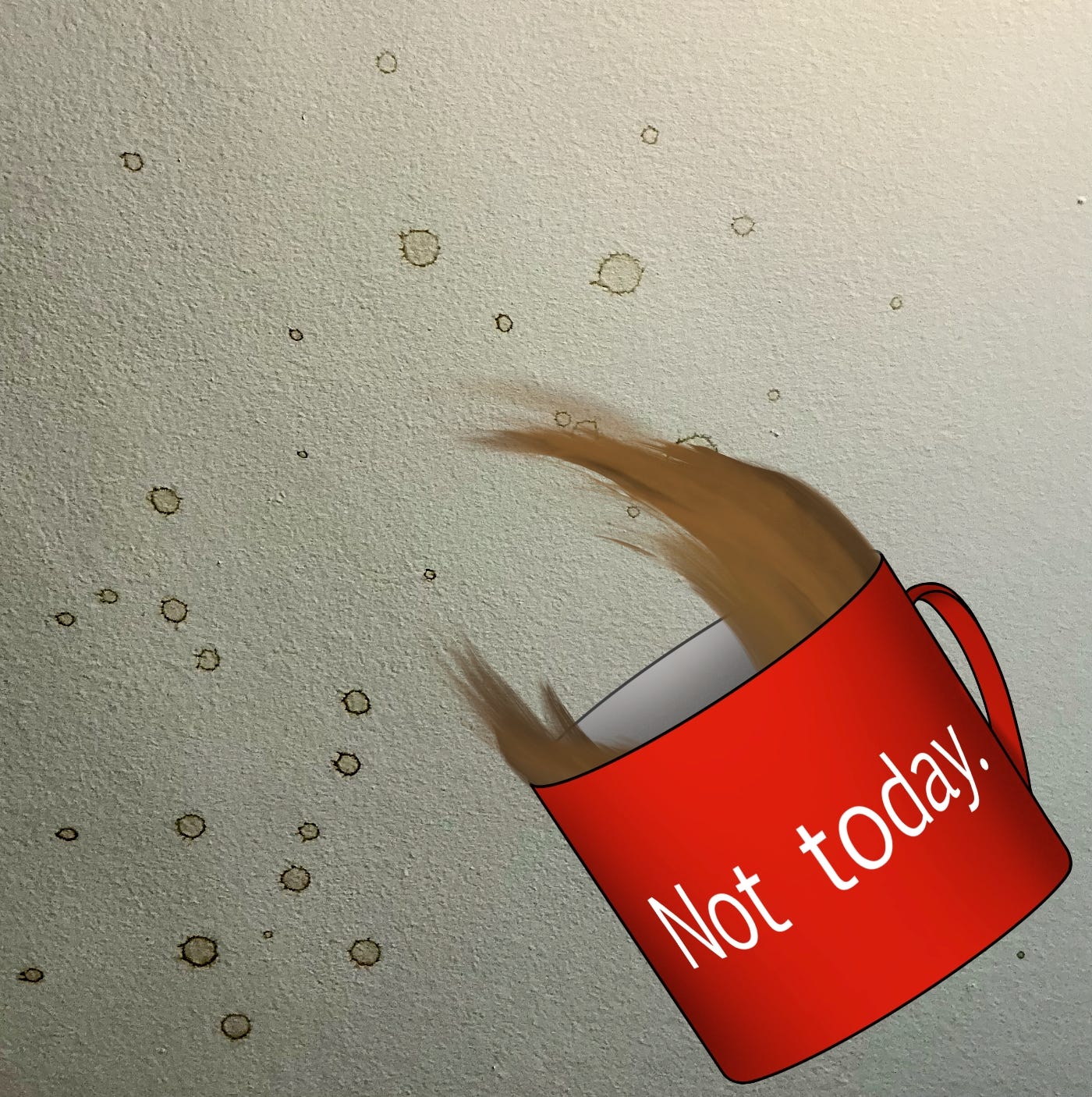Some families debate politics.
Other families debate religion.
In our house, we debate the physics of coffee.
For months now, there has been a small coffee stain on the kitchen ceiling. We know where it came from: a cat knocked a cup of coffee off the kitchen bench, which crashed to the floor and sent coffee flying everywhere.
What we’ve been trying to figure out is how the coffee reached the ceiling after only falling from hip-height.
If you drop a ball, no matter how bouncy, with no added force, onto a flat and stationary surface, it cannot bounce higher than the point from where it was dropped. To do otherwise would be a violation of physical laws (and Newton himself would come to arrest you for such a crime.)
So every now and then, one of us looks at the ceiling, and comes out with a theory.
“Maybe the cat added extra force to the coffee cup with its paw?” - unlikely.
“Perhaps coffee is resistant to gravity?” - highly implausible.
After discussing this conundrum further with CommaDash’s resident scientist,
, we came upon the most likely answer: Fluid Dynamics and Worthington Jets.As illustrated in the embedded video, a Worthington Jet is an effect created in water (or suitably inviscid liquid, like coffee) whereby a smaller portion of water mass is ejected from the larger body at significantly higher velocity than whatever impacted it in the first place.
The coffee stain is rather small, suggesting only a small amount reached the ceiling (the cover image of this post shows the extent of it). Due to the fact that such a liquid can change its shape with minimal force, and split into smaller parts, presumably a large amount of the overall energy of the system was transferred into relatively small droplets from the original body of liquid; or, in other words, it likely underwent “energy focussing”.
Caffeine-Powered Jetstream
First, lets assume the cup makes contact with the ground bottom-first.
The bulk of the coffee is instantly redirected outwards, hits the edge of the cup, and redirects again upwards. The momentum moving away from the centre has created a low-pressure partial-vacuum called a “cavity”. This is similar to the voids created by rotating propellers in water.
There is suddenly an immense amount of force attracting all the surrounding matter back in to fill that void, which nature abhors. That, combined with the momentum of the liquid returning toward the centre after being redirected by the sides of the cup - assuming a perfectly spherical cavity - will cause it all to meet at one central point, where the only remaining direction is up.
However, instead of all the liquid in the vertical column meeting at the same time, you get a “zipper” effect. Think of it like a tube of toothpaste: there’s a tiny amount still in the bottom of the tube, and to extract it, you need to squeeze the tube starting from the bottom, and going all the way up.
Similarly, at the bottom of the cavity, there is a portion of liquid that will be squeezed through the middle by the force of the inward-rushing liquid body, driven both by the rebound against the edges of the cup *and* the pressure difference in the centre cavity.
This small liquid packet ends up with all of the kinetic energy of the rest of the system, giving it way more velocity than it had when the cup hit the ground.
Voila: coffee hits the ceiling.
Great, now that we’ve settled the debate, we can finally get on with more important things: like making more coffee.
Gotta have priorities.
Update: Things are heating up over at CommaDash HQ! We’ve been having a lot of fun learning all the ins and outs of hardcore academic statistics, and building out our vision for doing explorative and hypothesis-driven analysis. Our prototype continues to advance in leaps and bounds. If you’re a scientist (or non-scientist even) interested in helping us shape the future of statistics, we’d love to hear from you!








Ha, indeed. I've noticed while washing dishes that even the mildest force from my hands in a glass can squirt soapy water a surprising distance. Usually onto me.
Years ago, babysitting a 4th grader. He was on his computer up in the loft; i was in the kitchen getting him an after school snack. There was yogurt. I was too lazy to run it up the stairs. He might have been okay to run down to the kitchen but I cleverly said: here, I'll toss it up to you. He stood at the loft railing. I tossed. Lousy toss. It just grazed his fingertips.... then smacked down to land exactly upright on the wood floor of the living room. This was one of those old Yoplaits with the truncated cone shaped (frustum) containers, narrower at the top with a foil seal. Yogurt absolutely freakin' GEYSERED straight up and out, speckling a swath of the slanted ceiling all the way up to the loft sky windows and leaving pink dots of yogurt high up on the walls several feet into the living room. It was a fabulous physics teaching moment that amused us both greatly. (His mom was a math/sci teacher and an astonishingly good sport when we described the incident later).
He's now in his 30s but we still LOL about the yogurt occasionally. He and his mom will get a kick out of this fine post, I will send it to them! 🤗⛲😄